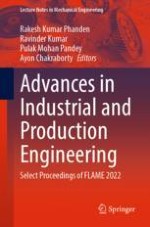This book comprises the select proceedings of the 3rd Biennial International Conference on Future Learning Aspects of Mechanical Engineering (FLAME) 2022. It aims to provide a comprehensive and broad-spectrum picture of state-of-the-art research and development in industrial and production engineering. Various topics covered include sustainable manufacturing processes, logistics & supply chains, Industry 4.0 practices, circular economy, lean six sigma, agile manufacturing, additive manufacturing, IoT and Big Data in manufacturing, 3D printing, simulation, manufacturing management and automation, surface roughness, multi-objective optimization and modelling for production processes, developments in casting, welding, machining, and machine tools and many more advancements in industrial and production engineering. This volume will prove a valuable resource for those in academia and industry working in the area of industrial and production engineering.
